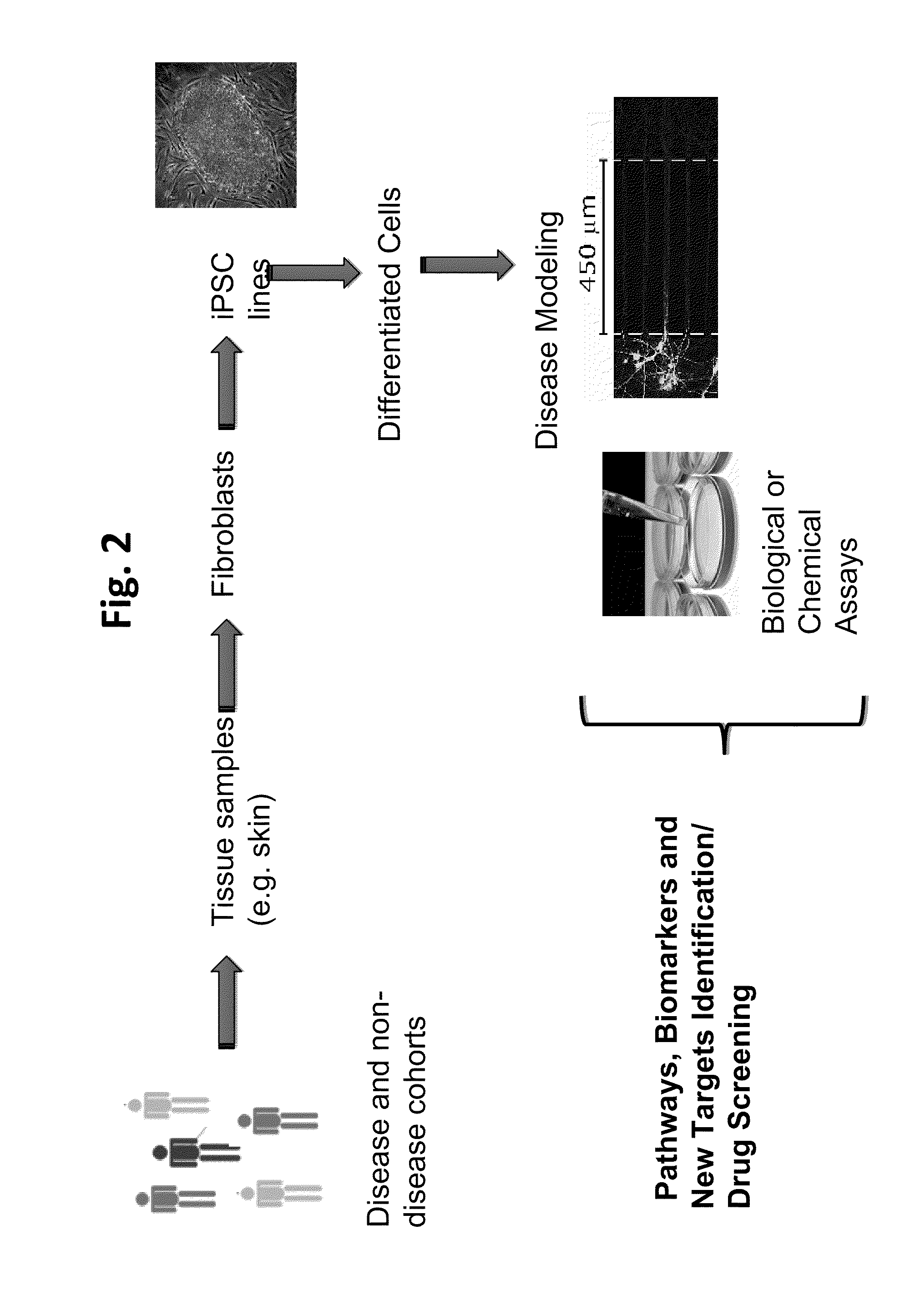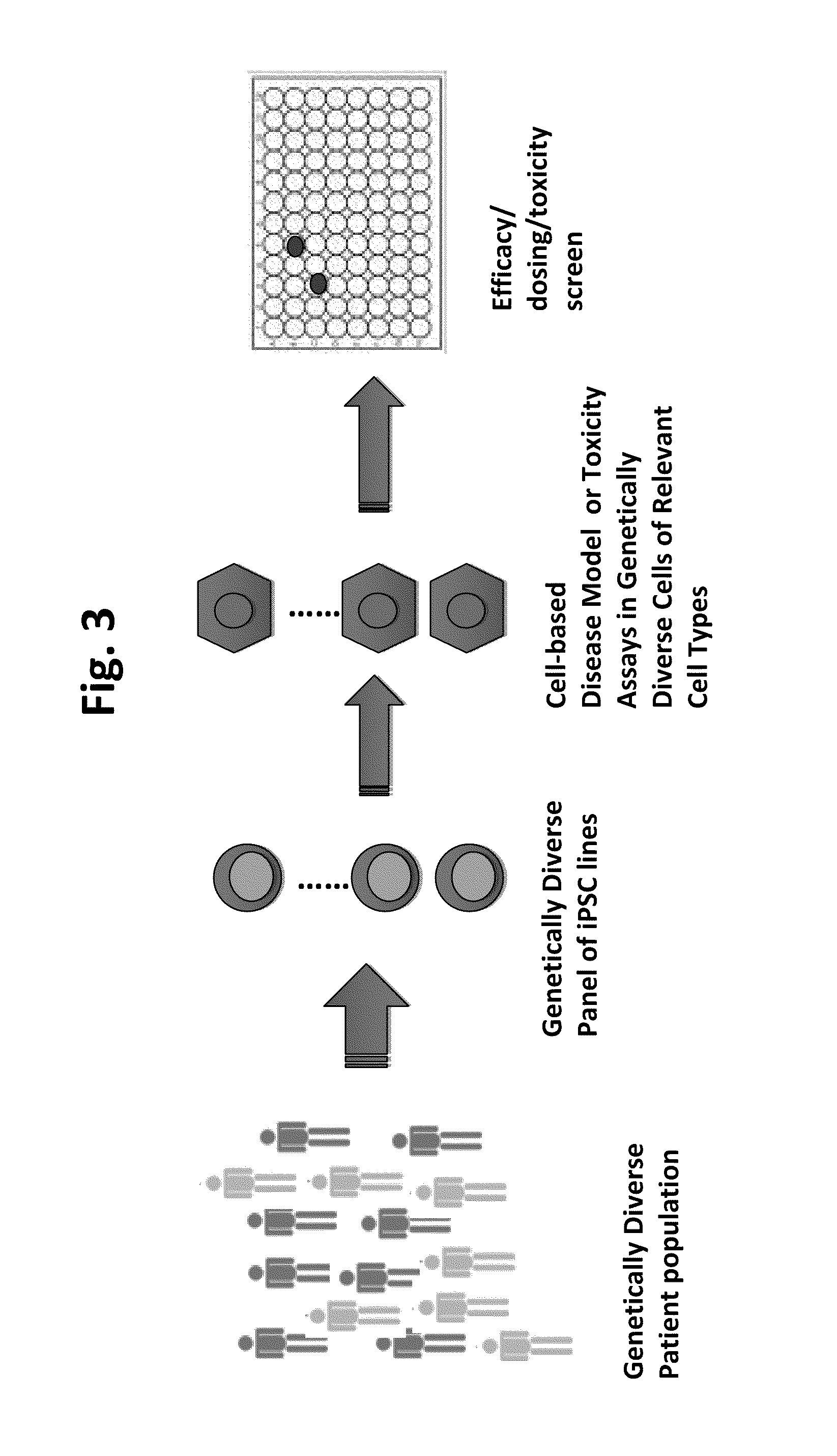Methods and platforms for drug discovery
a technology of drug discovery and platform, applied in the field of methods and platforms for drug discovery, can solve the problems of drug compounds that meet the expectations of preclinical models, small number of cell lines, toxic or ineffective when administered to human clinical trial patient populations, and cannot evaluate the efficacy and toxicity of candidate drugs in the context of the extreme genetic diversity of human patient populations. , to achieve the effect of reducing the risk of drug toxicity
- Summary
- Abstract
- Description
- Claims
- Application Information
AI Technical Summary
Benefits of technology
Problems solved by technology
Method used
Image
Examples
example 1
Generation of iPSC Lines from Patients Suffering from Spinal Muscular Atrophy
[0218]Spinal Muscular Atrophy (SMA) is a neuromuscular disease characterized by degeneration of motor neurons that is among the leading causes of childhood paralysis and mortality. The disease exhibits a wide range of severity affecting infants through adults, and is subdivided into types I-IV based on the age of onset and severity of symptoms: Type I “Infantile” onset at ages 0-6 months and generally fatal); Type II “Intermediate,” onset at ages 7-15 months; inability to stand or walk, but some ability to maintain a sitting position; Type III “Juvenile” onset at ages 18 months to 17 years, with some ability to walk, though potentially transient; Type IV “Adult,” some muscle weakness, but no genetic basis is known.
[0219]The molecular basis of SMA is linked to the Survival Motor Neuron (SMN) gene. The region of chromosome 5 that contains the SMN (survival motor neuron) gene has a large duplication. A large s...
example 2
Assay for Identification of Molecules that Improve Molecular and Cellular Disease Phenotypes in Motor Neurons from Patients Suffering from Spinal Muscular Atrophy
[0224]We seek to identify molecules that increase the level of SMN2E7 transcript in motor neurons derived from patients suffering from SMA. In principle, increased levels of SMN2E7 transcript can be increased by boosting SMN2 transcription, reducing degradation of SMN2 mRNA, or by increasing the fraction of SMN2 pre-mRNA that is spliced into SMN2E7 mRNA. SMA patient-specific motor neurons are obtained by first generating panels of iPS cell lines from Type I, Type II, and Type III SMA patients, as described in Example 1, and subsequently differentiating iPSCs into motor neurons. Prior to motor neuron differentiation SMA patient SMN2 minigene reporter iPSC lines are established to provide a convenient readout for the level of SMN2E7 transcript in motor neurons.
[0225]Following parental informed consent, standard dermal punch b...
example 3
Generation of iPSC Lines iPSCs from Patients with Idiopathic Parkinson's Disease and Defined Mutations in Genes Associated with Parkinson's Disease
[0232]Parkinson's Disease (PD) is one of the most common neurodegenerative diseases of aging, affecting 1-2% of the population over 65 years of age. Clinical symptoms include rest tremor, bradykinesia, and rigidity. We seek to generate a PD patient iPSC model to identify candidate therapeutic agents that slow, halt, or reverse PD progression.
[0233]iPSC lines are generated from skin biopsies obtained from 10 healthy control subjects with no known family history of PD, 10 patients with sporadic PD, patients each with mutations in the genes that encode α-synuclein (PARK1), parkin (PARK2), PINK 1 (PARK6), or LRRK2 (PARK8) for a total of 10 patients for each mutation. iPSCs are generated as described in Example 1. Afterwards, dopaminergic neurons are derived by differentiating each of the patient iPSC lines and control subject iPSCs. A dopamin...
PUM
| Property | Measurement | Unit |
|---|---|---|
| pH | aaaaa | aaaaa |
| pore size | aaaaa | aaaaa |
| pore size | aaaaa | aaaaa |
Abstract
Description
Claims
Application Information
 Login to View More
Login to View More - R&D
- Intellectual Property
- Life Sciences
- Materials
- Tech Scout
- Unparalleled Data Quality
- Higher Quality Content
- 60% Fewer Hallucinations
Browse by: Latest US Patents, China's latest patents, Technical Efficacy Thesaurus, Application Domain, Technology Topic, Popular Technical Reports.
© 2025 PatSnap. All rights reserved.Legal|Privacy policy|Modern Slavery Act Transparency Statement|Sitemap|About US| Contact US: help@patsnap.com



